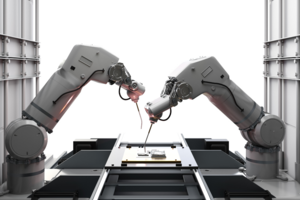AI: What’s in store for construction?

Chris Jones, Principal, Industrial and Transportation, sees the growing use of AI in the building sector as a positive development that will drive greater innovation and better collaboration.
Everyone seems to be talking about AI these days so I thought I would jump on the bandwagon myself, if only to learn more about what all the fuss is about. The usual refuseniks bleat about the perils of AI and a future without jobs, generally borne out of ignorance and the resultant fear it heralds. However, surprise, surprise, AI is already here.
Kids, always the first adopters of new technology, are using ChatGPT, Midjourney and Bard to do their homework (whether they are supposed to is another matter). But the world of construction, usually labelled ‘traditional’ and ‘outdated’, is already awash with this new technology. Here I will look at the opportunities and threats it presents.
BIM (Business Information Modelling) is already widely used across the sector, especially by larger companies who possess the budgets to invest in such resources. It is perhaps its incomplete adoption across projects that hampers its success. When designs or changes to designs are not shared across teams and with contractors and sub-contractors, then errors can occur impeding progress and busting budgets.
Yet decisions based on incomplete information, misinterpretations and flawed assumptions can be avoided by utilising technology such as Buildots AI, which provides real time, on-site data updates from a variety of sensors, cameras and image analysis technologies. Proper use of this technology eliminates blind spots and can result in fewer site visits. Alongside this greater precision, the technology can be integrated with other software programs related to building plans, meaning all the information can be in one place and up to date. This should lead to greater efficiency and therefore reduced costs and timescales.
So what’s not to like? Well, as mentioned at the top of this piece, some fear the potential threat to jobs. Automation of mundane tasks has certainly led to job losses in other industries such as manufacturing and logistics and the increased use of robots for activities like bricklaying is already replacing humans in some areas. However, humans are still required to create the specific programs and currently these machines are not sufficiently aware of their surroundings on building sites, which can be messy and unstructured places, to be fully autonomous.
It is likely that AI will have the biggest impact in the areas of design, surveying and project management. AI can help manage huge amounts of data and engineering calculations, thereby increasing accuracy and making people’s jobs less mundane and more efficient. It could also ensure all quality and safety standards are addressed and met. Data from previous projects, which once may have been discarded, can now be analysed to take leanings forward to new projects.
Risk mitigation is another area where predictive technology can foresee problems that are likely to arise, allowing them to be addressed in time. This may make awkward or potentially hazardous sites more open to development.
Rather than replacing humans, this can help them be more productive and innovative. We are unlikely to get to the point where AI does all of this with no human ‘checks’. It is hard to imagine a scenario taking place without any human interaction between a developer and an end client. Experts will still be needed to evaluate the information, designs, plans and so forth that AI produces.
Furthermore, AI is unlikely to ever be faultless. Experts will be required to unravel and provide opinion on mitigations and alterations. AI can also be incorporated into a built asset as a means of prolonging its lifespan and utilisation, creating better value for money.
Clearly, AI can already be found in the world of construction and over the next 10 years its impact on the sector will only increase. Yes, some roles may well disappear. But this will hopefully be offset by the creation of new ones related to the use of AI.
Technology is more likely to make current roles more efficient and less mundane by allowing greater innovation and collaboration. It also has a role to play in raising safety and quality standards.
As ever with the advancement of technology, it is those who embrace its use soonest that will reap the benefits. But don’t throw away your hard hats just yet.







Comments
No comments have yet been posted, be the first to comment by using the form below:
Add your comment